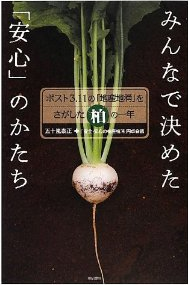Igarashi, Yasumasa et al. Minna de kimeta “anshin” no katachi: posuto 3.11 no “jisan jishō” o sagashita Kashiwa no ichinen. Aki shobō, 2012.
 The Great East Japan Earthquake of 11 March, 2011 and the subsequent accident at the Fukushima Daiichi nuclear power plant created large numbers of victims and a considerable amount of disarray. This is an ongoing situation, in which food safety has been subject to great scrutiny. The work presented here gives an account of the measures stemming from the ‘Anzen, Anshin’ [safe and trustworthy] round table that addressed issues relating to agricultural products in Kashiwa City, Chiba Prefecture during the aftermath of the disaster. The material provided in the book is likely to provide lessons for a range of issues relating to 3.11 and STS-related topics, such as public engagement.
The Great East Japan Earthquake of 11 March, 2011 and the subsequent accident at the Fukushima Daiichi nuclear power plant created large numbers of victims and a considerable amount of disarray. This is an ongoing situation, in which food safety has been subject to great scrutiny. The work presented here gives an account of the measures stemming from the ‘Anzen, Anshin’ [safe and trustworthy] round table that addressed issues relating to agricultural products in Kashiwa City, Chiba Prefecture during the aftermath of the disaster. The material provided in the book is likely to provide lessons for a range of issues relating to 3.11 and STS-related topics, such as public engagement.
I will first give a rough sketch of the background and sequence of events as presented in this work. The stage for this case study is Kashiwa City, Chiba Prefecture. Before the disaster there was an ‘eat local’ movement that promoted the consumption of vegetables grown in Kashiwa city and the surrounding region. However, this movement, which was just gaining steam, was derailed by the disaster. Radioactive materials released during the accident at the Fukushima Daiichi nuclear power plant were carried by wind, turning Kashiwa City into a radiation hotspot. As a consequence, shoppers turned away from locally sourced produce. According to Igarashi’s survey, rather than displaying increased enthusiasm for locally grown food, there is a greater trend toward buying produce sourced from elsewhere. Against this backdrop, there have been attempts to determine how best to measure radiation and how to decide on acceptable standards.
There are two particular aspects that I would like to address. One is the significance of the practice of ‘measuring’ and the means by which it is accomplished. The other is the attempt to decide rules together. Kashiwa city is a case where acceptable ‘rules’, ‘measuring methods’ and ‘standards’ are decided in the face of the various effects (including societal ones) of radioactive materials. Naturally, attempting to carry out measurements independently is not an easy process. It involves various stakeholders, including consumers, famers, restaurants using local produce, and administrators. Furthermore, dealing with radioactive matter is a delicate issue. Differences in values and of opinions are thus inevitable. So, how is measuring carried out and rules decided on in practice? In Kashiwa city, people considered it possible to ‘measure’ the radioactive substances by themselves and, out of necessity, create the rules and the system in which to do so. People, things (equipment and instruments), ideas, and cooperation were essential to surmount this challenge. Taking responsibility for ‘measuring’ entailed various difficulties. If radiation is not shielded, it fluctuates, and measuring radiation in a specific area is a difficult operation, particularly when measuring small amounts. They eventually decided to examine produce taken from a specific area of cultivated land where the radiation was highest, using highly accurate devices capable of detecting even nuclides. When determining which areas radioactive material was likely to accumulate, they drew upon the farmers’ expertise of the area (direction of wind, flow of water, etc.), which may bring to mind similar research conducted by Brian Wynne. In addition, in light of the new problems that have been encountered since the disaster, they learned about many things, not least of all how to use instruments and carry out measurements. Furthermore, those involved have engaged in discussions, gained expertise, have taken joint ownership of the challenges encountered in that process, and have engaged in a process of mutual learning to achieve a resolution to these problems.
One other matter that had to be decided was what food safety standards would be acceptable. In Japan, following the disaster the new food safety standard value was set at 100 bq/kg; however, in the Kashiwa trials, this value had to consider reasonably achievable standards. For farmers, the food safety standard value had to be:
… a figure that they would be able to achieve through a strict quality management based on an understanding the present conditions of the cultivated area. For consumers, who are rather concerned about radiation, it is a figure on which they are willing to compromise or can ‘tolerate’. For grocers selling local produce, it is a figure that their consumers, who are able to choose freely, will not judge unfavourably with produce from other areas. And, for those carrying out the measurements (using BekuMiru), it is a figure that is technically and financially feasible to achieve by measuring several samples. (pp 59-60)
They thus decided on a figure of 20bq/kg, or one-fifth of the new food safety standard figure.
The involvement of various stakeholders and residents, the mutual learning achieved through the activity of ‘measuring’, and the process that aimed for actual ‘consent’ and ‘agreement’, all hold lessons for science and technology studies, and debates on public engagement with science and technology. As an example of latest approach to the delicate issues concerning the spread of radioactive materials, the Kashiwa case cannot be ignored.
Ryuma Shineha, The Graduate University for Advanced Studies
English translation of Japanese original: Ruselle Meade, JSPS Postdoctoral Fellow, University of Tokyo
![[Teach311 + COVID-19] Collective](https://blogs.ntu.edu.sg/teach311/files/2020/04/Banner.jpg)